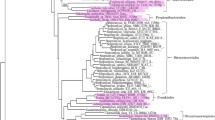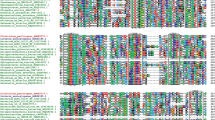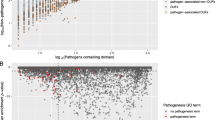Abstract
PASTA domains are small modules expressed in bacteria and found in one or multiple copies at the C-terminal end of several penicillin binding proteins (PBPs) and Ser/Thr protein kinases (STPKs) and represent potential targets for a new class of antibiotics. PASTA domains are currently annotated as sensor domains, as they are thought to activate their cognate proteins in response to binding to opportune ligands. However, recent studies have shown that PASTA domains linked to proteins of different classes, STPKs or PBPs, do not share the same binding abilities. Despite this, there is currently no way to distinguish between PASTA domains from the two classes, since all of them share the same fold, independent of the class they belong to. To identify a predictive tool of class identification, we here analyse a pool of parameters, including amino acid compositions and total charges of PASTA domains either linked to PBPs or to STPKs. We screened sequences from Actinobacteria, Firmicutes and Bacteroidetes. The first two phyla include some of the most dangerous micro-organisms for human health such as Mycobacterium tuberculosis and Staphylococcus aureus. Based on this analysis, our study proposes a predictive method to assign PASTA domains with unknown origin to their corresponding enzyme class, based solely on sequence information.




Similar content being viewed by others
References
Barthe P, Mukamolova GV, Roumestand C, Cohen-Gonsaud M (2010) The structure of PknB extracellular PASTA domain from Mycobacterium tuberculosis suggests a ligand-dependent kinase activation. Structure 18:606–615. https://doi.org/10.1016/j.str.2010.02.013
Bateman A et al (2004) The Pfam protein families database. Nucleic Acids Res 32:D138–D141. https://doi.org/10.1093/nar/gkh121
Berisio R (2015) Editorial: Molecular determinants of bacterial diseases. Curr Med Chem 22:1640–1641
Bernardo-Garcia N et al (2018) Allostery, recognition of nascent peptidoglycan, and cross-linking of the cell wall by the essential penicillin-binding protein 2x of Streptococcus pneumoniae. ACS Chem Biol 13:694–702. https://doi.org/10.1021/acschembio.7b00817
Calvanese L et al (2014) Structural and binding properties of the PASTA domain of PonA2, a key penicillin binding protein from Mycobacterium tuberculosis. Biopolymers 101:712–719. https://doi.org/10.1002/bip.22447
Calvanese L, Falcigno L, Squeglia F, D’Auria G, Berisio R (2017a) PASTA in penicillin binding proteins and serine/threonine kinases: a recipe of structural, dynamic and binding properties. Curr Med Chem 24:4038–4056. https://doi.org/10.2174/0929867324666170216112746
Calvanese L, Falcigno L, Squeglia F, D’Auria G, Berisio R (2017b) Structural and dynamic features of PASTA domains with different functional roles. J Biomol Struct Dyn 35:2293–2300. https://doi.org/10.1080/07391102.2016.1217274
Correale S, Ruggiero A, Capparelli R, Pedone E, Berisio R (2013) Structures of free and inhibited forms of the l, d-transpeptidase LdtMt1 from Mycobacterium tuberculosis. Acta Crystallogr D Biol Crystallogr 69:1697–1706. https://doi.org/10.1107/S0907444913013085
Dworkin J (2015) Ser/Thr phosphorylation as a regulatory mechanism in bacteria. Curr Opin Microbiol 24:47–52. https://doi.org/10.1016/j.mib.2015.01.005
Dworkin J, Shah IM (2010) Exit from dormancy in microbial organisms. Nat Rev Microbiol 8:890–896. https://doi.org/10.1038/nrmicro2453
Gordon E, Mouz N, Duee E, Dideberg O (2000) The crystal structure of the penicillin-binding protein 2x from Streptococcus pneumoniae and its acyl-enzyme form: implication in drug resistance. J Mol Biol 299:477–485. https://doi.org/10.1006/jmbi.2000.3740
Letunic I, Bork P (2017) 20 years of the SMART protein domain annotation resource. Nucleic Acids Res. https://doi.org/10.1093/nar/gkx922
Maestro B et al (2011) Recognition of peptidoglycan and beta-lactam antibiotics by the extracellular domain of the Ser/Thr protein kinase StkP from Streptococcus pneumoniae. FEBS Lett 585:357–363. https://doi.org/10.1016/j.febslet.2010.12.016
Maurer P, Todorova K, Sauerbier J, Hakenbeck R (2012) Mutations in Streptococcus pneumoniae penicillin-binding protein 2x: importance of the C-terminal penicillin-binding protein and serine/threonine kinase-associated domains for beta-lactam binding. Microb Drug Resist 18:314–321. https://doi.org/10.1089/mdr.2012.0022
Mir M, Asong J, Li X, Cardot J, Boons GJ, Husson RN (2011) The extracytoplasmic domain of the Mycobacterium tuberculosis Ser/Thr kinase PknB binds specific muropeptides and is required for PknB localization. PLoS Pathog 7:e1002182. https://doi.org/10.1371/journal.ppat.1002182
Nikitushkin VD, Demina GR, Shleeva MO, Guryanova SV, Ruggiero A, Berisio R, Kaprelyants AS (2015) A product of RpfB and RipA joint enzymatic action promotes the resuscitation of dormant mycobacteria. FEBS J 282:2500–2511. https://doi.org/10.1111/febs.13292
Ogawara H (2016) Distribution of PASTA domains in penicillin-binding proteins and serine/threonine kinases of Actinobacteria. J Antibiot (Tokyo) 69:660–685. https://doi.org/10.1038/ja.2015.138
Paracuellos P et al (2010) The extended conformation of the 2.9-A crystal structure of the three-PASTA domain of a Ser/Thr kinase from the human pathogen Staphylococcus aureus. J Mol Biol 404:847–858. https://doi.org/10.1016/j.jmb.2010.10.012
Pares S, Mouz N, Petillot Y, Hakenbeck R, Dideberg O (1996) X-ray structure of Streptococcus pneumoniae PBP2x, a primary penicillin target enzyme. Nat Struct Biol 3:284–289
Ruggiero A, Marasco D, Squeglia F, Soldini S, Pedone E, Pedone C, Berisio R (2010) Structure and functional regulation of RipA, a mycobacterial enzyme essential for daughter cell separation. Structure 18:1184–1190. https://doi.org/10.1016/j.str.2010.06.007
Ruggiero A, Squeglia F, Marasco D, Marchetti R, Molinaro A, Berisio R (2011) X-ray structural studies of the entire extracellular region of the serine/threonine kinase PrkC from Staphylococcus aureus. Biochem J 435:33–41. https://doi.org/10.1042/BJ20101643
Ruggiero A, De Simone P, Smaldone G, Squeglia F, Berisio R (2012) Bacterial cell division regulation by Ser/Thr kinases: a structural perspective. Curr Protein Pept Sci 13:756–766
Ruggiero A, Squeglia F, Romano M, Vitagliano L, De Simone A, Berisio R (2016) The structure of resuscitation promoting factor B from M. tuberculosis reveals unexpected ubiquitin-like domains. Biochim Biophys Acta 1860:445–451. https://doi.org/10.1016/j.bbagen.2015.11.001
Ruggiero A, Squeglia F, Romano M, Vitagliano L, De Simone A, Berisio R (2017) Structure and dynamics of the multi-domain resuscitation promoting factor RpfB from Mycobacterium tuberculosis. J Biomol Struct Dyn 35:1322–1330. https://doi.org/10.1080/07391102.2016.1182947
Sauvage E, Kerff F, Terrak M, Ayala JA, Charlier P (2008) The penicillin-binding proteins: structure and role in peptidoglycan biosynthesis. FEMS Microbiol Rev 32:234–258. https://doi.org/10.1111/j.1574-6976.2008.00105.x
Shah IM, Laaberki MH, Popham DL, Dworkin J (2008) A eukaryotic-like Ser/Thr kinase signals bacteria to exit dormancy in response to peptidoglycan fragments. Cell 135:486–496. https://doi.org/10.1016/j.cell.2008.08.039
Squeglia F et al (2011) Chemical basis of peptidoglycan discrimination by PrkC, a key kinase involved in bacterial resuscitation from dormancy. J Am Chem Soc 133:20676–20679. https://doi.org/10.1021/ja208080r
Squeglia F, Ruggiero A, Berisio R (2015) Exit from mycobacterial dormancy: a structural perspective. Curr Med Chem 22:1698–1709
Squeglia F, Ruggiero A, Berisio R (2018) Chemistry of peptidoglycan in Mycobacterium tuberculosis life cycle: an off-the-wall balance of synthesis and degradation. Chemistry 24:2533–2546. https://doi.org/10.1002/chem.201702973
Sutcliffe IC (2010) A phylum level perspective on bacterial cell envelope architecture. Trends Microbiol 18:464–470. https://doi.org/10.1016/j.tim.2010.06.005
Tipper DJ, Strominger JL (1965) Mechanism of action of penicillins: a proposal based on their structural similarity to acyl-d-alanyl-d-alanine. Proc Natl Acad Sci USA 54:1133–1141
Typas A, Banzhaf M, Gross CA, Vollmer W (2012) From the regulation of peptidoglycan synthesis to bacterial growth and morphology. Nat Rev Microbiol 10:123–136. https://doi.org/10.1038/nrmicro2677
Yeats C, Finn RD, Bateman A (2002) The PASTA domain: a beta-lactam-binding domain. Trends Biochem Sci 27:438. https://doi.org/10.1016/S0968-0004(02)02164-3
Acknowledgements
We thank the High Performance Scientific Computing Lab of the Department of Science and Technology—University of Naples “Parthenope” for helpful discussion and suggestions about the statistical treatment of data.
Author information
Authors and Affiliations
Corresponding author
Ethics declarations
Conflict of interest
The authors declare no conflicts of interest.
Research involving human participants and/or animals
The research program did not involve human participants or animals. No informed consent was therefore needed.
Additional information
Handling Editor: L. Taher.
Electronic supplementary material
Below is the link to the electronic supplementary material.
Rights and permissions
About this article
Cite this article
Calvanese, L., Falcigno, L., Squeglia, F. et al. PASTA sequence composition is a predictive tool for protein class identification. Amino Acids 50, 1441–1450 (2018). https://doi.org/10.1007/s00726-018-2621-8
Received:
Accepted:
Published:
Issue Date:
DOI: https://doi.org/10.1007/s00726-018-2621-8




